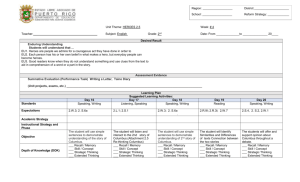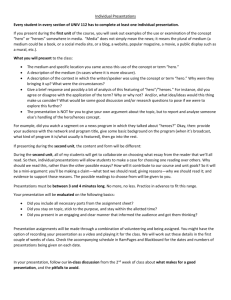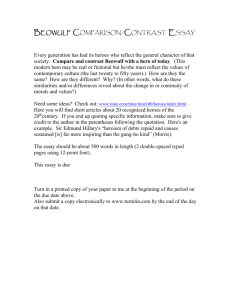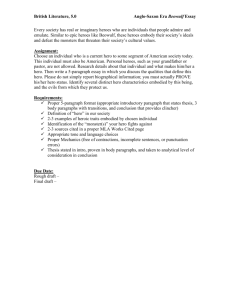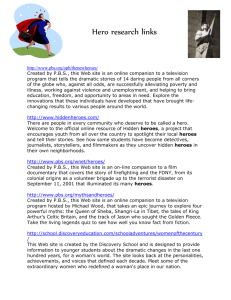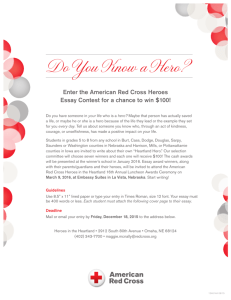Unit 2.5: Heroes English as a Second Language 5 weeks of instruction
advertisement
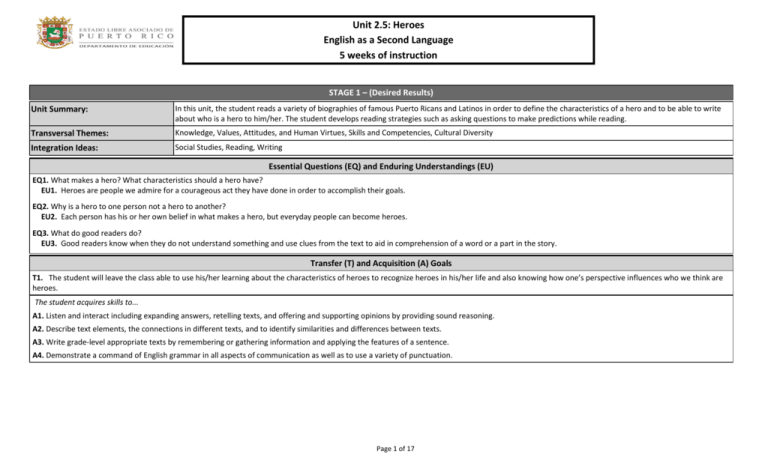
Unit 2.5: Heroes English as a Second Language 5 weeks of instruction STAGE 1 – (Desired Results) Unit Summary: In this unit, the student reads a variety of biographies of famous Puerto Ricans and Latinos in order to define the characteristics of a hero and to be able to write about who is a hero to him/her. The student develops reading strategies such as asking questions to make predictions while reading. Transversal Themes: Knowledge, Values, Attitudes, and Human Virtues, Skills and Competencies, Cultural Diversity Integration Ideas: Social Studies, Reading, Writing Essential Questions (EQ) and Enduring Understandings (EU) EQ1. What makes a hero? What characteristics should a hero have? EU1. Heroes are people we admire for a courageous act they have done in order to accomplish their goals. EQ2. Why is a hero to one person not a hero to another? EU2. Each person has his or her own belief in what makes a hero, but everyday people can become heroes. EQ3. What do good readers do? EU3. Good readers know when they do not understand something and use clues from the text to aid in comprehension of a word or a part in the story. Transfer (T) and Acquisition (A) Goals T1. The student will leave the class able to use his/her learning about the characteristics of heroes to recognize heroes in his/her life and also knowing how one’s perspective influences who we think are heroes. The student acquires skills to... A1. Listen and interact including expanding answers, retelling texts, and offering and supporting opinions by providing sound reasoning. A2. Describe text elements, the connections in different texts, and to identify similarities and differences between texts. A3. Write grade-level appropriate texts by remembering or gathering information and applying the features of a sentence. A4. Demonstrate a command of English grammar in all aspects of communication as well as to use a variety of punctuation. Page 1 of 17 Unit 2.5: Heroes English as a Second Language 5 weeks of instruction Puerto Rico Core Standards (PRCS) Listening 2.L.1 Listen and interact with peers during social interactions, read-alouds, and class, group, and partner discussions. 2.L.1a Ask and answer questions appropriate to the topic and offer opinions in conversations using learned phrases and open responses. 2.L.1c Listen and respond to increasingly complex instructions, commands, and directions. 2.L.1g Listen and respond to simple 5W questions. Speaking 2.S.1 Participate in class, group, and partner discussions by listening attentively, following turn-taking rules, and asking and answering questions with confidence about personal experience and texts using complete sentences. 2.S.2 Exchange common social and more formal greetings, retell texts, and recount experiences, using increasingly detailed complete sentences. 2.S.2b Use words, phrases, and expanded sentences to express ideas for a variety of purposes (e.g., communicate needs and desires). 2.S.2c Expand sentences to provide details (e.g., time, manner, place, cause) in shared language activities guided by the teacher and sometimes independently. 2.S.3 Retell conversations and fictional and informational texts; and respond to stories, read-alouds, and presentations orally using a growing number of general academic and content-specific words. 2.S.4 Offer and support opinions by providing good reasons and increasingly detailed examples from experience and text. 2.S.6a Retell texts and recount experiences using complete sentences, key words, and a growing number of general academic and domain‐specific words in order to add detail while speaking. Reading 2.R.1 Describe ideas, phenomena (e.g., erosion), and text elements (e.g., central message, character traits) using greater detail based on understanding of a variety of grade‐level and readaloud texts and viewing of multimedia with light support. 2.R.3I Describe the connection between two individuals, events, ideas, or pieces of information in an informational text. 2.R.3L Describe how characters in a story respond to major events and challenges. 2.R.9I Identify basic similarities in and differences between two informational texts on the same topic (e.g., in illustrations, descriptions, or procedures). Writing 2.W.1 Write to express feelings, familiar topics, experiences, and describe a picture; use grade-level appropriate high frequency words (e.g., Dolch list) to write simple sentences. 2.W.3 Collaborate with peers to draw and write literary texts; use grade-level appropriate high frequency words (e.g., Dolch list) to write simple sentences. 2.W.7 Remember information about experiences or gather information from a variety of sources (e.g., word wall, book talks, grade-appropriate texts) to answer a question in writing. Page 2 of 17 Unit 2.5: Heroes English as a Second Language 5 weeks of instruction Writing Foundational Skills 2.W.FS.9 Apply the distinguishing features of a sentence when writing (e.g., first word, capitalization, ending punctuation). Language 2.LA.1 Demonstrate command of English grammar and usage when writing or speaking. 2.LA.2 Demonstrate command of the conventions of English capitalization, punctuation, and spelling when writing. 2.LA.2b Use punctuation for declarative, interrogative, and exclamatory sentences. 2.LA.2f Use conventional spelling for grade appropriate words with common spelling patterns and for some irregular words. 2.LA.2g Consult reference materials, including dictionaries, as needed to check and correct spellings, using the ability to alphabetize by the first two letters. 2.LA.3 Use knowledge of language and its conventions when writing, speaking, reading, or listening. 2.LA.3a Choose words and phrases for different purposes (e.g., slang, written vs. spoken, formal vs. informal). 2.LA.6 Use words and phrases acquired through conversations, reading and being read to, and responding to texts, including using adjectives and connecting words (e.g., conjunctions like and because). Page 3 of 17 Unit 2.5: Heroes English as a Second Language 5 weeks of instruction STAGE 1 – (Desired Results) Alignment to Learning Objectives PRCS: 2.L.1a 2.L.1g 2.R.1 2.S.1 2.W.1 EQ/EU: EQ2/EU2 Content Focus (The student understands…) That heroes are people we admire for a courageous act they have done in order to accomplish their goals. STAGE 2 – (Assessment Evidence) Content Vocabulary T/A: A1 A2 T1 5W question words (who, what, where, when, why) and how Admire Challenge, difficulty Characteristic, trait (helpful, brave, honest, kind, talented, intelligent, dedicated, hardworking, caring, curious) Goal Hero, heroic Perspective, experience Performance Tasks Other Evidence Oral Assessment Integrated Assessment 2.3 Before completing this unit, the teacher should administer the first integrated assessment to students (see Attachment: “Integrated Assessment 2.3”). Page 4 of 17 STAGE 3 – (Learning Plan) Learning Activities For sample lessons related to the following group of learning activities, refer to the section ‘Sample Lessons’ at the end of this map. Oral Assessment of Word Wall Vocabulary and Individual Vocabulary (see Building Background and Vocabulary: “What attachment: Resource 1 – Oral makes a Hero?” Assessment for Vocabulary Acquisition) The teacher asks the student, “What makes a hero? What characteristics should he/she have?” and the student brainstorms with a partner or in a small group a list of actions and traits a hero has. The student shares with the group and explains why. As the student is describing, the teacher creates a class word web for the word “hero” on the board or on chart paper. The teacher uses this preliminary vocabulary for the class word wall and/or individual word lists. The teacher asks the question, “Who is a hero in your life?” and the student shares with the group. Over the unit, the student’s notion of heroes changes because at first, it can be famous people (like musicians or actors), but then it changes to encompass people in his/her life. The student creates a drawing or comic (see attachment: 2.5 Learning Activity – Comic Strip) of his/her hero doing something he/she admires and writes an explanation Unit 2.5: Heroes English as a Second Language 5 weeks of instruction Page 5 of 17 for why this person is his/her hero. The student shares his/her pictures with a partner and the partner asks the 5W questions to learn more about his/her classmates hero (Who is it? Where is he/she? Why is he/she your hero? What does he/she do? When did he/she live?). When reading biographies on heroes, the teacher creates a class list of heroes’ traits to note how they can accomplish different tasks. The teacher lists the information in a four column chart: 1) Book, 2) Hero, 3) Why is this person a hero? 4) What are his/her heroic traits? Unit 2.5: Heroes English as a Second Language 5 weeks of instruction STAGE 1 – (Desired Results) Alignment to Learning Objectives PRCS: 2.L.1 2.L.1a 2.LA.1 2.LA.2 2.LA.2b 2.LA.2f 2.R.3L 2.S.1 2.S.2b 2.S.4 2.W.1 2.W.FS.9 EQ/EU: EQ4/EU4 T/A: A1 A3 A4 T1 Content Focus (The student understands…) How to make a prediction. What a good reader does to assist in comprehension. STAGE 2 – (Assessment Evidence) Content Vocabulary Clue, text, unknown word Infer (I infer the word means _____ because ____) Predictions (I predict _______ will happen because ____) Question mark, exclamation point, period Performance Tasks Other Evidence For complete descriptions, refer to the section ‘Performance Tasks’ at the end of this map. A Hero in My Life Step 1: The student writes a letter of appreciation to a family member he/she admires. The student selects a family member who is a hero to him/her and writes a letter to share why this person is a hero. Step 2: The letter includes different sentence types (question, exclamation, statement, as taught). The teacher uses attachment 2.5 Performance Task – Descriptive Writing Rubric to assess the letter. STAGE 3 – (Learning Plan) Learning Activities Sight Words/ Dolch Words Monitoring For sample lessons related to the following group of learning activities, refer to the section ‘Sample Throughout the year the Lessons’ at the end of this map. teacher teaches a set of five to seven Dolch Words a week to Making Predictions using Biographies on Heroes improve the student’s fluency. The teacher uses attachment To teach predictions, the teacher asks, 2.5 Other Evidence – Dolch “What do good readers do when they read? Checklist to monitor the Do they just read or are they thinking while student’s progress in acquiring they are reading? What are they thinking Dolch Words. about?” The teacher shares how good readers wonder about what will happen next as they read because they are curious. This is called a “prediction.” “To make a prediction we need to use what we know (from our lives) and clues from the text to predict what will happen next.” The teacher models how to make predictions in a read aloud text, and also shows how to confirm predictions during reading. The teacher uses predictions as a way to confirm the notion of the “hero’s journey,” the idea that something difficult happened in a hero’s life that catapulted him/her towards his/her dream (e.g., Frida Kahlo had an accident as a child and she painted from her bed as she recuperated) or how heroes work hard (Pele began playing soccer with balls he made himself). Based on the childhood, the Page 6 of 17 Unit 2.5: Heroes English as a Second Language 5 weeks of instruction Page 7 of 17 student predicts what this person will do to become a hero. The student reads books with a partner to practice making predictions. The student uses a sticky note to stop and write his/her predictions in a notebook, or uses attachment 2.5 Learning Activity – Making Predictions Organizer. During the closing of the lesson, the student shares what predictions he/she made with the group, why, and whether or not he/she was correct. Unit 2.5: Heroes English as a Second Language 5 weeks of instruction STAGE 1 – (Desired Results) Alignment to Learning Objectives PRCS: 2.L.1 2.L.1a 2.L.1g 2.R.3I 2.R.9I 2.S.2 2.S.2c 2.S.3 2.S.6a EQ/EU: EQ2/EU2 EQ3/EU3 T/A: A1 A2 T1 Content Focus (The student understands…) That a hero depends on the perspective of the people (e.g., Columbus was a hero for Spain but not to the Taino). Particular heroes/characters in fiction and nonfiction. STAGE 2 – (Assessment Evidence) Content Vocabulary 5W question words (who, what, where, when, why) and how Admire Challenge, difficulty Characteristic, trait (helpful, brave, honest, kind, talented, intelligent, dedicated, hardworking, caring, curious) Christopher Columbus (explorer, discover, ship, crew, gold, Spain, India, trade, enslave, murder) Goal Hero, heroic Perspective, experience Performance Tasks STAGE 3 – (Learning Plan) Other Evidence Social Language Observation During morning message, story time and instructions, the teacher uses attachment, Resource 7 – Social Language Rubric, to note growth of the student’s ability to follow instructions, and participate during read alouds. Learning Activities For sample lessons related to the following group of learning activities, refer to the section ‘Sample Lessons’ at the end of this map. Asking Questions through studying Christopher Columbus as a heroic figure Page 8 of 17 The teacher shows Columbus’ journey to the Americas on a World Map. The teacher shares that during this time European countries wanted to trade with India and wanted to find a new route or way to get there. The teacher asks if it makes sense for Christopher Columbus to sail west. The student shares his/her answer. The teacher asks, “Why is a hero to one person not a hero to another?” The teacher shares how one student has different heroes than another student in the class. The teacher asks: “Why do we not have the same hero? Is it because of our values or what we think is important?” The teacher reads aloud two different biographies on Christopher Columbus (Christopher Columbus and Encounter). The teacher facilitates a discussion with students to compare and contrast histories of Columbus and to analyze his personality traits. “Do the authors portray him as a hero Unit 2.5: Heroes English as a Second Language 5 weeks of instruction Page 9 of 17 or otherwise?” The teacher creates a class Tchart listing the story line to show how the texts focus on different parts of the same story. During the read aloud of both books, the teacher asks 5W questions (e.g., Why did Columbus sail west? What did he want? Where did he land? How was he feeling then? When did the Spanish land in the Americas? Where did he think he was? What did he think of the Taino? What did the Taino think of the Spanish? What did the Spanish do to the Taino?). During read alouds, the student turns to a partner and shares his/her answers. The student also develops questions and asks his/her partner the questions. The student creates a four tab foldable with “who, what, why, how” on flaps, illustrates each part on the inside and writes a sentence in the inside of each flap (see attachment: 2.5 Learning Activity – Four Door Foldable). The student makes the foldable for each biography to focus on how different perspectives shape the story (Christopher Columbus focuses on discovery for trade, while Encounter focuses on enslavement for gold). The student completes 2.5 Learning Activity – Making Predictions Organizer to share his/her own thoughts and predictions about the Columbus journey and to predict whether or not Columbus is a hero to the Taino , Spanish, or modern day people. Unit 2.5: Heroes English as a Second Language 5 weeks of instruction Page 10 of 17 The student compares and contrasts the book Encounter with Christopher Columbus by making a Venn Diagram on Christopher Columbus (actions, traits) with attachment, 2.5 Learning Activity – Venn Diagram or by creating a three tab foldable book (see attachment 2.5 Other Evidence – Three Tab Foldable). Unit 2.5: Heroes English as a Second Language 5 weeks of instruction STAGE 1 – (Desired Results) Alignment to Learning Objectives PRCS: 2.L.1c 2.LA.1 2.LA.2 2.LA.2b 2.LA.2f 2.LA.2g 2.LA.3 2.LA.3a 2.LA.6 2.S.4 2.W.1 2.W.3 2.W.7 2.W.FS.9 Content Focus (The student understands…) That a hero depends on the perspective of the people (e.g., Columbus was a hero for Spain but not to the Taino). Particular heroes/characters in fiction and nonfiction. STAGE 2 – (Assessment Evidence) Content Vocabulary Capitalization, uppercase, lowercase, capital letter Complete thought Question mark, exclamation point, period Performance Tasks For complete descriptions, refer to the section ‘Performance Tasks’ at the end of this map. Other Evidence Fluency Check Taino Diary: Is Columbus a Hero? EQ/EU: EQ2/EU2 EQ3/EU3 T/A: A3 A4 T1 Step 1: The student creates a diary of a Taino boy or girl who was there during the encounter with Columbus and his crew. The student creates a diary entry of five or six days, including drawings of what the Taino child saw, heard, and thought of Columbus. The student brainstorms with the class about what kind of questions would go through the mind of the Taino to come to the conclusion of whether or not Columbus is a hero. Step 2: To build background, the student needs to have already read two biographies on Columbus, created the four tab books using 5W questions, and Page 11 of 17 STAGE 3 – (Learning Plan) Learning Activities For sample lessons related to the following group of learning activities, refer to the section ‘Sample Lessons’ at the end of this map. The student reads aloud to check for fluency or any words that the student has difficulty Writing Focus: Sentence Types with – intonation, skipped words, and missed endings During the prediction lessons and inferring (see attachment: Resource 8 – unknown words, the teacher shares how Paired Reading Fluency Check he/she is asking questions and how as an evaluation). questions need a question mark. The teacher asks how writing question marks is different in English. The teacher notes how question marks are not written at the beginning of a sentence as in Spanish, but only at the end, as well as how question words are often used at the beginning of many questions (e.g., “When did Columbus arrive to the Americas?” not “Columbus arrived to the Americas, when?”). The teacher models four sentence types and what punctuation they need: 1) Statements use a period 2) Commands can use a period or exclamation 3) Exclamations use an exclamation mark 4) Questions use a question mark. The teacher creates a chart and the student finds examples of questions, exclamations, statements and commands in books and writes the sentences on the class chart. Unit 2.5: Heroes English as a Second Language 5 weeks of instruction compared and contrasted the portrayal of Christopher Columbus in both books. Another background the teacher can give the students is from 2.5 Sample Lesson – Rethinking Columbus, in which students create a courtroom to decide who is responsible for the death of indigenous people in the Americas (Note: This is higher level English. As a teacher, you can adapt parts of the lesson or use facts from the lesson to have the student role play court using sentence starters). Step 3: The student uses various sentence types (questions, exclamations, statements) and vocabulary from the unit in his/her diary. The teacher uses 2.1 Performance Task – Descriptive Writing Rubric to assess writing. Page 12 of 17 The teacher creates a four table foldable book (see attachment: 2.5 Learning Activity – Four Door Foldable). The student illustrates and gives examples of sentences with sentence types (question, statements, exclamations, commands). Unit 2.5: Heroes English as a Second Language 5 weeks of instruction STAGE 3 – (Learning Plan) Suggested Literature Connections Biographies on Columbus: Stephen Krensky (From a Eurocentric Perspective) o Christopher Columbus (Step into Reading, Step 3) Jane Yolen (from a Taino Perspective) o Encounter Puerto Rican Biographies: Lucia Gonzalez (first Puerto Rican librarian in US) o The Storyteller’s Candle/La velita de los cuentos Jonah Winter o Sonia Sotomayor- A Judge grows in the Bronx Willie Perdomo o Clemente! Jonah Winter o Roberto Clemente: The Pride of the Pittsburgh Pirates Linda George o “Luis Munoz Marin (Community Builders” Latin American Biographies: Julia Durango o Peter Claver, Patron Saint of Slaves/Pedro Claver, santo patrono de los esclavos Monica Brown o Pele King of Soccer, El rey del futbol Monica Brown o My Name is Celia/Me llamo Celia: The Life of Celia Cruz Monica Brown o My name is Gabito/Mi llamo Gabito: The life of Gabriel Garcia Marquez Jonah Winter o Frida Page 13 of 17 Unit 2.5: Heroes English as a Second Language 5 weeks of instruction Jonah Winter o Diego Books to teach Predictions: Ann Cameron o The Stories Huey Tells Chris Van Allsburg o Two Bad Ants Pat Hutchins o The Doorbell Rings Allen Say o Grandfathers Journey Chris Van Allsburg o The Garden of Abdul Gasazi Scott Foresman Reading – Collection 1.3 Let’s Learn Together Book and Practice Book B.G. Hennessy page 10 (Realistic Fiction) o The Big Mess Scott Foresman Reading – Collection 1.5 Take Me There Book and Practice Book Lily Hong page 44 (Realistic Fiction) o A Big Day for Jay Gail Saunders-Smith page 114 (Social Studies Connection) o Communities Fay Robinson page 182 (Character Traits) o The True Story of Abbie Burgess Additional Resources Lessons using primary source letters from Columbus when he arrived to the Caribbean. You can adjust the level to meet the student needs by translating in Spanish or paraphrasing, but it is interesting to give student access to primary source documents: http://edsitement.neh.gov/lesson-plan/what-was-columbus-thinking#sect-activities Page 14 of 17 Unit 2.5: Heroes English as a Second Language 5 weeks of instruction Reading with Meaning: Teaching Comprehension in the Primary Grades by Debbie Miller (an excellent book on teaching reading strategies to young readers) Page 15 of 17 Unit 2.5: Heroes English as a Second Language 5 weeks of instruction Performance Tasks A Hero in My Life Step 1: The student writes a letter of appreciation to a family member he/she admires. The student selects a family member who is a hero to him/her and writes a letter to share why this person is a hero. Step 2: The letter includes different sentence types (question, exclamation, statement, as taught). Use attachment 2.5 Performance Task – Descriptive Writing Rubric to assess the letter. Taino Diary: Is Columbus a Hero? Step 1: The student creates a diary of a Taino boy or girl who was there during the encounter with Columbus and his crew. The student creates a diary entry of five or six days, including drawings of what the Taino child saw, heard, and thought of Columbus. The student brainstorms with the class about what kind of questions would go through the mind of the Taino to come to the conclusion of whether or not Columbus is a hero. Step 2: To build background, the student needs to have already read two biographies on Columbus, created the four tab books using 5W questions, and compared and contrasted the portrayal of Christopher Columbus in both books. Another background you can give students is from Lesson, 2.5 Sample Lesson – Rethinking Columbus, where the students create a courtroom to decide who is responsible for the death of indigenous people in the Americas (note: this is higher level English. As a teacher, you can adapt parts of the lesson or use facts from lesson to have the student role play court using sentence starters from lesson). Step 3: The student uses various sentence types (questions, exclamations, statements) and vocabulary from the unit in his/her diary. The teacher uses 2.1 Performance Task – Descriptive Writing Rubric to assess writing. Page 16 of 17 Unit 2.5: Heroes English as a Second Language 5 weeks of instruction Suggested Sample Lessons See attachment: 2.5 Sample Lesson – Rethinking Columbus (This contains information for the teacher on Columbus that uses primary source accounts about Columbus’ encounter with the Taino. The court activity is for older students, but it contains helpful information for the teacher and can be adapted for younger students with simpler sentences. This can only be done after students have built background and vocabulary by reading biographies on Columbus from different perspectives so they can make up their own minds about Columbus’ effect on the Americas). Three lessons on making predictions while reading: http://www.readworks.org/lessons/grade2/predicting The teacher uses a guessing game to help develop language and ways to use clues to make a prediction: http://www.readwritethink.org/classroom-resources/lesson-plans/guess-what-languagebased-124.html Page 17 of 17

